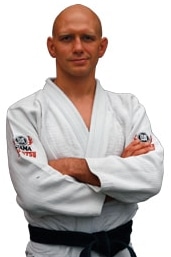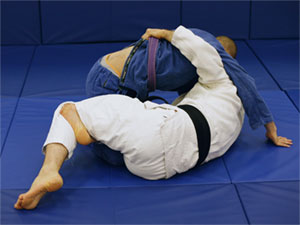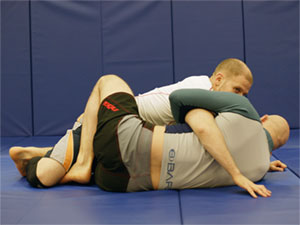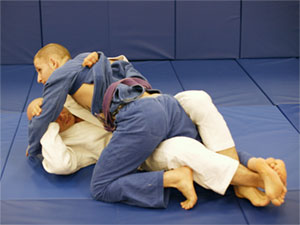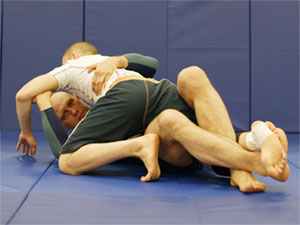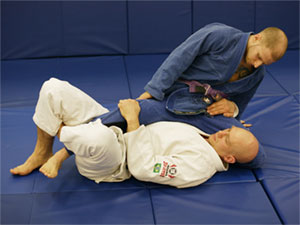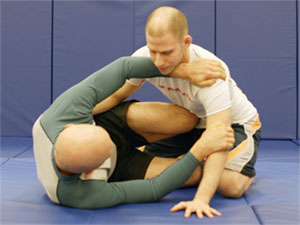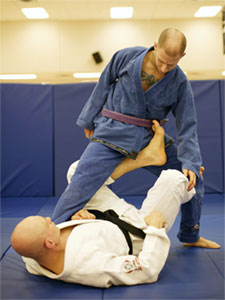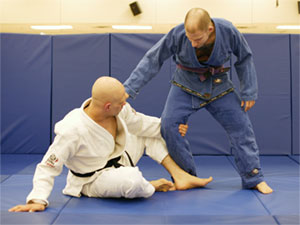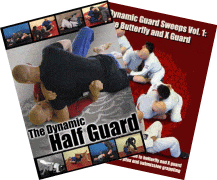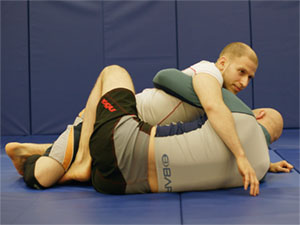
By Stephan Kesting and Elliott Bayev
Principal Photography by Keith Haist
Originally Published in Ultimate Grappling Magazine
This is the third and final article in a series introducing a wide variety of guard positions. Today we are going to tackle the Half Guard, where you have only one of your opponent’s legs trapped between your own. Previous articles were dedicated to variations of the Closed Guard and the Open Guard, and readers should be aware that these classifications are somewhat porous, there being areas of overlap between styles and variations of guard work.
Half Guard is a very common position in jiu-jitsu, as guard passes rely on first getting to Half Guard, and many pin escapes also result in Half Guard rather than Full Guard. Years ago it was seen as a pitiful position, just one step before having your guard passed. From the 1990s to today, however, this position has evolved considerably. Jiu-jitsu practitioners realized that the Half Guard allowed them to get right under an opponent’s center of gravity which in turn led to the development of whole series of new sweeps.
One of the catalysts for this change was Roberto “Gordo” Correa, a Brazilian black belt who had an injured knee, which prevented him from playing a more typical guard game. He started having a lot of success from the Half Guard and when he started winning tournaments with it the word was out: the Half Guard was no longer an inferior position
Since that revelation other people have explored and expanded the offensive potential of the Half Guard and today it is the favored sweeping position of some of the best jiu-jitsu and submission grappling competitors in the world.
Standard Half Guard
|
|
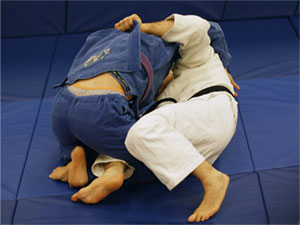 A similar position, grabbing the far lapel behind the back and hooking only with the bottom leg |
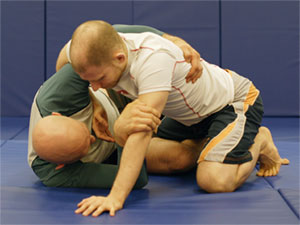 In no gi with the bottom leg hooking the opponent’s right leg |
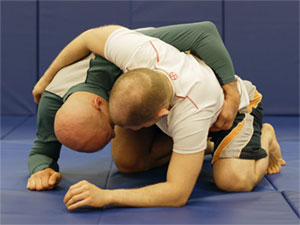 Coming onto the knees from the Half Guard with an underhook |
We are using the term ‘Standard Half Guard’ to describe a situation where you are on your side using your inside leg to hook one of your opponent’s legs and have some sort of underhook with your top arm. There are many minor variations to this position, including having your legs triangled, gripping his gi or his belt, etc.
Standard Half Guard is great for taking the back, sweeping an opponent by getting under their hips, and coming up to your knees, which greatly enhances your ability to sweep.
Grapplearts recently released a highly reviewed DVD on the half guard covering the strategies, attacks and sweeps available from this position.
Half Butterfly
|
|
 …and with an underhook |
The Half Butterfly combines the Half Guard and the Butterfly Guard into a very powerful sweeping position. You are on your side with your bottom leg hooking your opponent’s leg and the instep of your top leg buried under his thigh. Your arms can be in a variety of positions including the overhook (photo 1) and the underhook (photo 2).
Maintaining the butterfly hook with one leg offers several advantages. If returning to guard is your goal then it provides a leverage point to swing back into Butterfly Guard as soon as your opponent relaxes his forward and downward pressure onto you. If you want to use this position offensively, the hook allows you to lift his leg and manipulate him in a variety of ways to sweep him. Finally, placing your foot in this position nullifies many of the most common leglock attacks available to your opponent in Standard Half Guard. The main thing that you have to watch out for in Half Butterfly is your opponent pushing your top knee down with his hand and popping his leg over top of it, directly into mount!
For more information check out The Dynamic Half Guard DVD, which has a section covering the half butterfly.
Double Triangle
|
|
|
The Double Triangle Half Guard position, also named the “Lockdown” position by Eddie Bravo, is a solid way to prevent your opponent from passing your Half Guard and also to set up various sweeps and submissions. This position has also been used in Japanese Judo, although primarily as a stalling position.
Typically you will use this position with at least one underhook, if not two. Both of your insteps are tucked under something: the foot of your inside leg is snug against your opponent’s shin or instep, and the foot of your outside leg is tucked under your own inside leg. Controlling your opponent’s leg this way makes your half guard difficult to passand makes it possible to attack your opponent’s posture by stretching out his body. Once his posture is gone you have a variety of sweeps, and even a few submissions, available to you.
Deep Half Guard
|
|
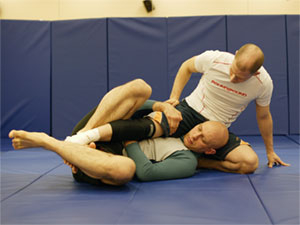 In no gi, with one butterfly hook inserted under the opponent’s lower leg |
In the Deep Half Guard you are – as the name implies – deep underneath your opponent’s hips. Typically you are trying to keep your body turned onto its side, and can control either your opponent’s hip (1st picture) or your opponent’s thigh (2nd picture) with your top arm. The legs can do a variety of things, including triangling around the opponent’s leg, butterfly hooking underneath it and more.
The Deep Half Guard is primarily used for sweeping your opponent and has very few submission attacks available from it. This position and some of the techniques associated with it was the subject of a Grappling Tip post on our Blog. To date it has not found a lot of application in mixed martial arts competition, probably for fear of getting punched in the face. Perhaps a future competitor will yet come along and offer some new insight into using this position in an MMA context…
Z Guard
|
|
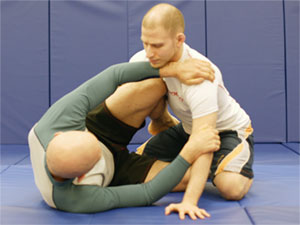 The same position with the top knee pushing in the chest/shoulder area |
The Z Guard, thus named by Leo Kirby, is also known as a Knee-In Half Guard. This guard is shown here in a no gi situation, but it is equally useful with the gi. In this position the bottom leg hooks your opponent’s leg while the top knee maintains distance between you and him by pushing into his hip, chest or shoulder. From here you have both sweeps and submissions available to you, Kimura armlocks and various collar chokes being the most popular.
With the gi, you typically hold the far collar with your top hand and your opponent’s sleeve with your bottom hand. Without the gi you often frame his neck with your forearm while controlling his far arm to prevent him from controlling your head and neck.
X Guard
|
|
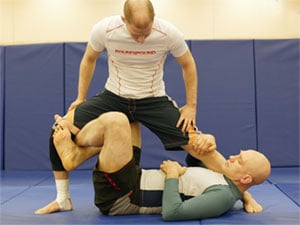 A variation with the feet crossed the other way and both positioned at the opponent’s knee (left foot over right foot) |
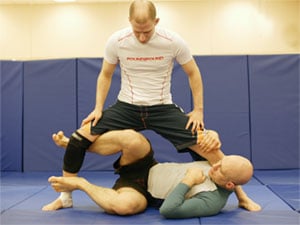 The Scissored X Guard variation |
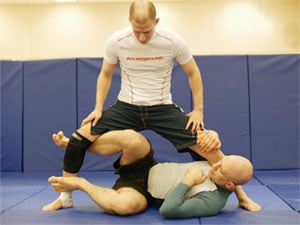 The X Guard applied against a kneeling opponent, here shown with an ankle lock style grip |
Marcello Garcia popularized the X Guard when he used it to cut a swath through the competition at ADCC 2003. In the X-Guard, your whole body is positioned between the opponent’s legs, stretching them apart. This provides a great ability to destabilize, sweep and leglock the opponent. In the X Guard you keep your opponent’s leg on your shoulder, not in the crook of your arm, which is a common mistake. Your hand at his kneecap helps control his top leg.
There are several leg position variations; we will discuss four of them. All these variations offer powerful sweeping options.
- In the first, most popular, variation (1st photo) you have one leg behind his knee and the other in the crease of his hip.
- In another variation (2nd photo) you stack your legs differently and position both at the knee.
- In the Scissor X Guard position (3rd position) you are lying even more on your side, with one foot behind his knee and the sole of your other foot pushing near his ankle.
- Finally the X Guard can be applied against kneeling opponents, either with his foot on your shoulder (as in the first three photos) or even in an ankle lock style grip (4th photo).
The X Guard can be used by a variety of body types and usually offers great control of your opponent upon completion of your sweep. For more information on this position you can check out the Butterfly and X Guard DVD available on this site.
Sitting Half Guard
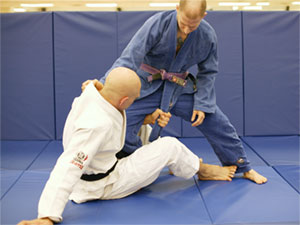
The Sitting Half Guard, gripping the lapel with the
hand of the arm that goes around the leg
The Sitting Guard is one way to deal with an opponent standing up in front of you: you sit up, bringing your chest to his shin, your legs to either side of his lead foot, hug his leg from the outside with one arm and post on the ground behind you with the other. Gripping your opponent’s belt, lower lapel (shown in the photo) or the sleeve of one of his arms make the position even more secure.
Most of your offensive options from this position are sweeps; although it is possible to apply a few leglocks from the Sitting Guard, they probably won’t be enough to base your offense around them. Sitting Guard transitions well to Deep Half Guard, Instep Guard and X-Guard.
Note that some BJJ practitioners use the term “Sitting Guard” to refer to the Butterfly Guard position rather than the position shown in this photograph. Other practitioners use the same term to describe a position in which one is sitting up and stiffarming an opponent with one arm.
Instep Guard
|
|
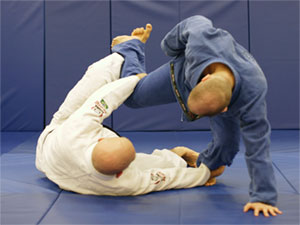 The position being used to sweep an opponent |
This position, also known as the Shin Guard, is similar to the Sitting Guard position with the addition of your instep being placed across your opponent’s instep. While this is a seemingly minor variation, it allows you to tremendously destabilize your opponent by lifting his foot off the ground. It is also a lot less gi-dependent a position than the sitting guard.
Your arm secures the back of his leg in one of two ways: shallow (shown in these pictures) with the hand at the back of the knee, or deeply with the entire forearm. Both the shallow and deep versions are good, and they both work with and without the gi.
| The Half Guard and the Butterfly Guard make a fantastic sweeping combo.Click here to find out more about our 2 DVD guard sweeps package with high percentage guard attacks you can start using right away. | Other articles in this series:
Other articles about the half guard
|

